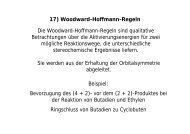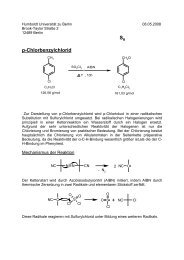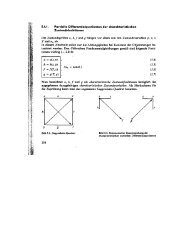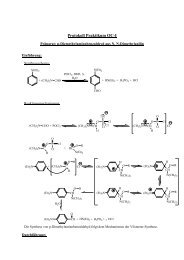Gas-Phase Reactions of Homo- and ... - Institut für Chemie
Gas-Phase Reactions of Homo- and ... - Institut für Chemie
Gas-Phase Reactions of Homo- and ... - Institut für Chemie
Create successful ePaper yourself
Turn your PDF publications into a flip-book with our unique Google optimized e-Paper software.
1414<br />
Helvetica Chimica Acta ± Vol. 88 (2005)<br />
C H bond no longer seems accessible. Instead, with butanenitrile, only the formation<br />
<strong>of</strong> the formal association complex [Fe 2C 4H 7N] ‡ , without indication for any bond<br />
activation reactivity, is observed. This behavior is consistent with the scenario proposed<br />
in Scheme 3 in that the alkyl chain <strong>of</strong> butanenitrile is too short to assist the formation <strong>of</strong><br />
cyclic species.<br />
Scheme 3. Model for the 1,1-Elimination from Pentanenitrile by Fe ‡ 2<br />
Given that an exocyclic MCTS is energetically more favorable than an endocyclic<br />
variant, the 1,2-elimination <strong>of</strong> H 2 from pentanenitrile is suggested to proceed via an<br />
initial activation <strong>of</strong> a C H bond in the g position (Fig. 2; 20a). The alternative d-C H<br />
bond activiation would lead to 17 (Scheme 3), from which an endocyclic MCTS had to<br />
be formed to bring about loss <strong>of</strong> H 2 via the 1,2-elimination mode. Although not<br />
rigorously proven, the initial activation at the g position appears more plausible.<br />
However, while for the reaction <strong>of</strong> Fe ‡ 2 with pentanenitrile the intermediate 20a (Rˆ<br />
CH 3) is capable to undergo an additional exocyclic C H bond activation step, from 20b<br />
(Rˆ H) elimination <strong>of</strong> H 2 would imply the formation <strong>of</strong> an endocyclic MCTS. This<br />
latter option does not seem to exist, <strong>and</strong> H 2 is generated neither from n-C 3H 7CN/Fe ‡ 2<br />
nor from n-C 3H 7CN/FeCo ‡ under thermal conditions.<br />
Fig. 2. Proposed structure for the intermediate resulting from the insertion <strong>of</strong> Fe ‡ 2 in the g-<br />
C H bond <strong>of</strong> pentanenitrile (20a) <strong>and</strong> butanenitrile (20b)<br />
As to the structural <strong>and</strong> electronic details <strong>of</strong> all <strong>of</strong> the RCN/MM' ‡ species <strong>and</strong> their<br />
initial C H bond activation intermediates discussed in this study, for the time being no<br />
reliable data are available, <strong>and</strong> appropriate computational investigations are indicated.<br />
This holds true in particular for the complexes with heteronuclear clusters, e.g., FeCo ‡ ,<br />
as for these systems quite a few interesting reaction scenarios with regard to the nature<br />
<strong>of</strong> the complexation as well as mechanistic details <strong>of</strong> activation steps are conceivable.<br />
<strong>Reactions</strong> <strong>of</strong> Ni ‡ 2 <strong>and</strong> CoNi ‡ Including Some Specific Aspects <strong>of</strong> C C Bond<br />
Activation. In terms <strong>of</strong> product formation, Ni ‡ 2 shows the richest pattern <strong>of</strong> all clusters<br />
studied, <strong>and</strong> this is also enlarged in comparison to atomic Ni ‡ . For Ni ‡ 2 , double<br />
dehydrogenation <strong>of</strong> pentanenitrile is observed with high efficiency, whereas simple<br />
dehydrogenation prevails for Ni ‡ [5b,c]. This result is in accord with the multiple



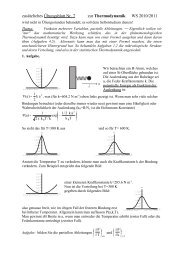
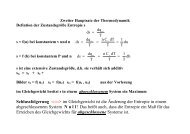
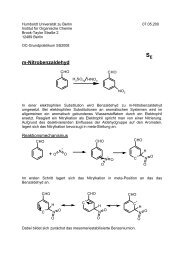
![Photoswitchable ionophores based on 1,3-alternate calix[4]arenes ...](https://img.yumpu.com/12290271/1/190x253/photoswitchable-ionophores-based-on-13-alternate-calix4arenes-.jpg?quality=85)
